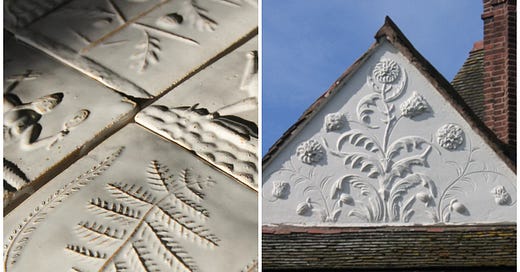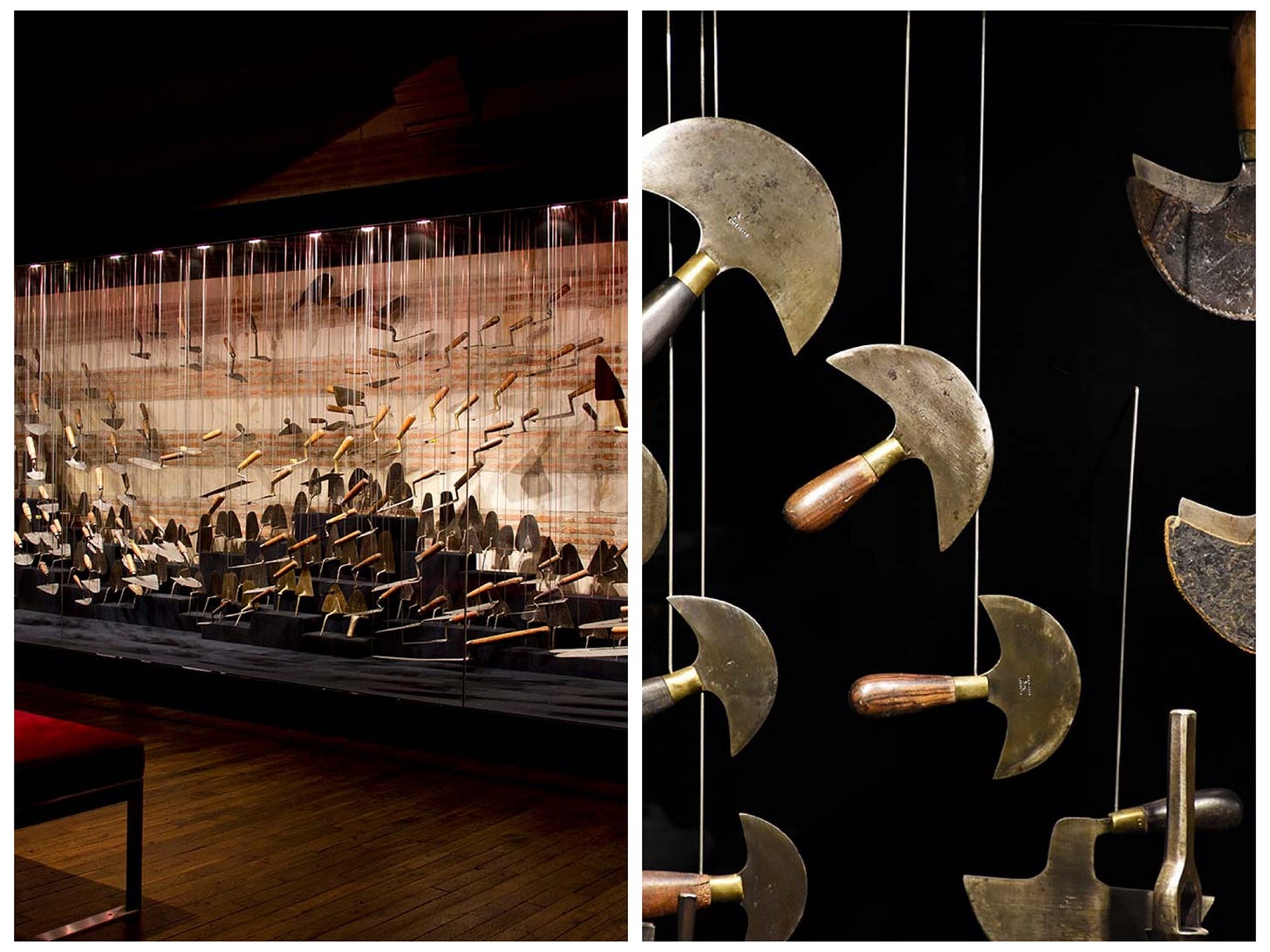Three Recent (Old) Discoveries
Folksy vernacular flourishes; spirit-lifting Alpine design; a tool museum in France; and a reading list.
CRAFT AND FABLE
Inspired by the delightful ancient art of pargeting—vernacular raised plaster decoration on medieval timbered buildings—UK artist Edith Morris’ handmade Folktale Tiles for The Shop Floor Project are based on Celtic, Nordic, Scandinavian, Baltic and Slavic folk stories. Take the legend of Bella Sheep Head—a West Cumbrian ghost story about a milkmaid who drinks the blood of her pet lamb after it’s killed by a fox, only to transform into a weresheep with horns. There are tales of a monster boar that only King Arthur could defeat; a headless man with eyes on his chest; Krampus; and a manticore with the face of a human, the body of a lion and the tail of a scorpion, who eats its victims whole, using its three rows of teeth, and leaves no bones behind.
Luckily, some of the buildings that these tiles take inspiration from have been preserved, most notably in Suffolk, Essex and Norfolk. The Landmark Trust (you know how much we love the Landmark Trust) has made the fittingly named Ancient House available for holiday rentals in the Suffolk market town of Clare. An excellent example of elaborate freehand pargeting, the house is considered one of the finest examples of the craft—which we imagine would bring a bit of joy and much-needed flora to the bleakest winter months of the year.
FOR THE LOVE OF TOOLS
My love for small, esoteric, little-known museums knows no bounds, and I have a perpetually running list. Especially museums dedicated to elevating the mundane, celebrating the beauty of simple, common, everyday objects. A friend recently introduced me the MOPO in Troyes, France, where humble, hardworking handmade tools are the shining stars of the beautiful installations. Yes! Hand tools! —“unique witnesses of the intergenerational transfer of craftsmen.” The collection is 12,000 tools strong, across 65 cases, and the contemporary way in which they’re presented—the “scenography”—provides an elevated juxtaposition to the ancient post-and-bean building it’s housed in. More museums like this, please.
A SPIRIT-LIFTING SWISS HOUSE MUSEUM
Don’t let the simple white-washed exterior of the Engadin Museum in St. Moritiz fool you: Inside, 21 rooms with traditional Swiss interiors are decorated with intricate hand-carved woodwork, colorful antiques, ceramics, and wool embroideries, some dating back to the 16th and 17th centuries.
The highly prized wood-paneled living rooms (called “stube”) originally came from villages and farmhouses in the valley and were painstakingly taken apart and reassembled. Dark snowy winters reduced the Swiss landscape to a monochromatic palette of black and white, and the brightly painted furniture and richly patterned everyday objects were a way for the villagers to add color back into their lives until the snow thawed and spring arrived. —LBG

ARMCHAIR ESCAPES
To get you through the last little gasp of winter.
To Read:
A few weeks ago, I contributed to Yolo Journal’s armchair travel reads. I only pulled my contributions below, but it is an epic list with so many excellent recommendations. As Alex Postman, Yolo’s Deputy Editor, writes in the intro:
“Great travel writing colors in landscape, character and chronology so you can slip mindfully into a place rather than blunder into it. It shows you how to roll with uncertainty and embrace serendipity; teaches you how to observe closely and find beauty unexpectedly; reveals truths about history, culture, colonial legacies and political upheavals at an empathetic human scale; pulls the scales off your eyes; and of course hooks you with relatable inner journeys that mirror the extraordinary outer one.”
What travel books would you say best capture the essence of a place or time—where and when?
Two Towns in Provence and As They Were by MFK Fisher, who writes as evocatively about place (Provence in the 70s) as she does about food. And A Visit to Don Otavio by Sybille Bedford for a thrilling journey across Mexico in the 60s. Think squeezing onto buses with live animals that get robbed by bandits and a remote hacienda at Lake Chapala. Laurence Durrell's Corfu Trilogy (especially My Family and Other Animals) about Corfu in the 30s—through the delightful prism of his eccentric family experience.
Are there books not traditionally considered travel narratives that so completely capture a world, you would recommend them for armchair travel?
I often prefer literature/memoir over travel narrative, because it gets under my skin in a deeper, different kind of way-- especially Italian writers. Beyond Elena Ferrante's Neopolian novels (I mean, can you even go to Naples without reading My Brilliant Friend, named the best book of the century (!!) by The New York Times?), there are too many world-capturing, soul-expanding books to list. Here's a start: The House on via Gemito by Domenico Starnone (also Naples); Arturo's Island (Procida) and Lies and Sorcery (Sicily) by Elsa Morante; Christ Stopped at Eboli by Carlo Levi (Matera); The Eight Mountains by Paolo Cognetti (Milan, Aosta Valley); ANYTHING by Natalia Ginsburg, but her memoir Family Lexicon (Dolomites, Turin) is my favorite. The Penguin Book of Italian Short Stories, edited by Jhumpa Lahiri, sits on my bedside table, so a literary escape—even just a few pages at a time—is never farther than arm's reach.
What book(s) do you always recommend when someone is visiting X country/city/place—and briefly, why?
Anyone heading to the South Pellopense needs to read Patrick Leigh Fermor's Mani, in which he traverses the harsh (then inhospitable) landscape of the Mani Peninsula by foot, offering an ethnographic (but still intimate) deep-dive into the culture and people along the way. His travels took place before the region opened up to tourism of any kind (sealed off by lack of infrastructure), but because the landscape looks just as rugged and natural today, it's not a stretch to imagine his adventures unfolding in front of you in real-time.
To Listen:
Gone to Timbuktu, the podcast series by brilliant travel journalist Sophy Roberts. She’s a thoughtful, curious, insightful and razor-sharp interviewer, and many of her guests are travel writers themselves (including Gail Simmons on the ancient pilgrimages/long-distance footpath from her book Between the Chalk and the Sea). The second season came out last week, and the first guest is Paul Theroux. They talk about his books, George Orwell (a lot), the death of travel writing, and a beautiful Doris Lessing quote that stopped me in my tracks:
“You may live in a place for months, even years, and it doesn’t touch you, but a weekend or a night in another and you feel as if your whole being has been sprayed with the equivalent of a cosmic wind.” —Doris Lessing from Under My Skin
To Watch:
Vermiglio for the time travel. This lush, slow-moving film about life in South Tyrol in the ‘40s is by no means an uplifting tale (I know, I know…), but the stunning Tyrollean landscape is so transportive and the emotive pull so powerful, you’ll find yourself in another time and place for two solid hours.
Would love to know your favorite travel reads! Drop into the comments below.







